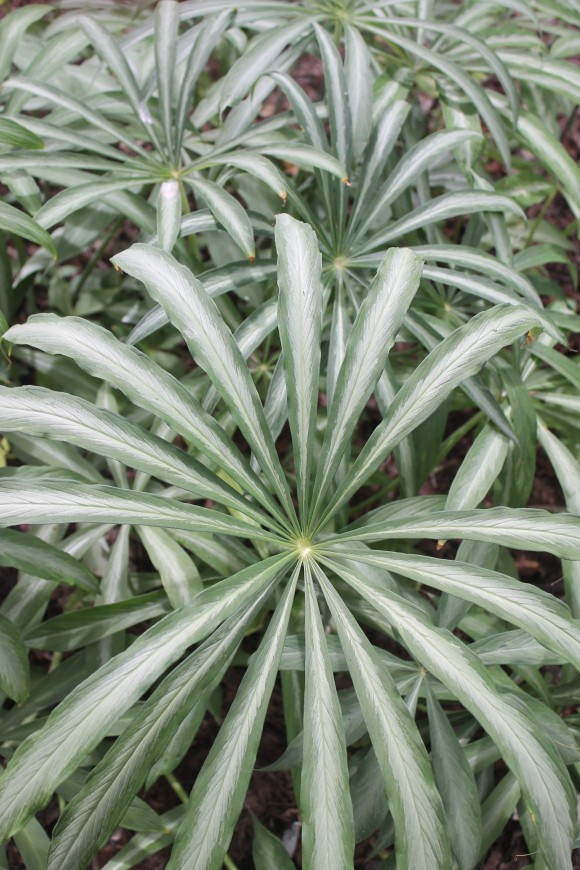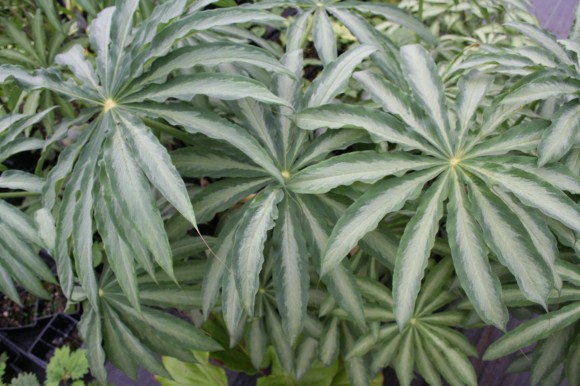
One of the biggest challenges that I found with high latitude (i.e. Maine gardening) gardening is looking for bold-foliaged plants that can take mild summers and cooler nights. There are the usual suspects: canna, caladium, and bananas but each of these plants really are slow to get growing and need a lot of winter care inside of a heated greenhouse to carry over. What we need in the garden is a hardy, bold plant that can provide the contrast in texture without the extra care of having to dig and overwinter in a heated greenhouse. Notice that I have used the phrase heated greenhouse twice, well, now three times. That is because I recently tallied all of our fuel bills for the past year to keep our greenhouse warm over the winter. Holy smokes! Let’s just say that this year, we are looking for alternative ways to overwinter a few carefully selected tender plants without having to fire up the glasshouse heaters.
We are also growing the list of hardy plants that give the bold impact of a canna or caladium without the worry and expense of surprising and highly erratic propane bills.
Arisaema consanguineum, or Himalayan cobra lily
Top of the list is Arisaema consanguineum, or Himalayan cobra lily. Have you ever seen this plant? My first thought when I saw it in our gardens at Coastal Maine Botanical Gardens was, “there is no way that is hardy here!”
You know what? Not only is it hardy, it is thriving as we are seeing offsets and seedlings from the parent plants. The Himalayan cobra lily is reported to be hardy to at least USDA zone 5.
Let me know if you successfully grow this in zone 5 or even colder areas.

Our plants are perennials and emerge slowly in the spring while continuing to grow and expand, reaching a height of 3-4 feet. Our entire mass is now around 10 feet across. Each leaf is held aloft by a single basal stalk. This leaf is divided into 12 long and attractive leaflets. Each leaflet is approximately 12 inches long, making each leaf around 2 feet in diameter.
The really cool part of the leaflets can be the long leaf tip which varies in length by seedling. Some of these leaf tips look like threads hanging off of the end of the leaflet. Depending on the age of the plant, it may produce several leaf stalks from a single underground corm. As the planting matures, they take on the textural comparison of a small palm.

Another thing I really like about Arisaema consanguineum is the variability in the seedlings. Once established, the plants will flower with their exotic, cobra-esque, jack in the pulpit flowers and possibly even set seed.
From these seed, the possibilities are exciting. Ellen Hornig, at the now-shuttered Seneca Hill perennials, introduced some fine silver-leaved forms, including the cultivar ‘Poseidon.’ Poseidon has a soft, silver sheen and can grow as tall as 5 feet in height.
As for culture, I have found that Arisaema as a genus are somewhat forgiving of soil conditions but grow best in extremely rich, fertile loam with slightly higher than average moisture. A nice top dressing of compost in the spring can aid the plant to bulk up and multiply.
Now you know that Arisaema consanguineum is an outstanding plant on the top of my shopping list.
–Rodney
Images: Plant Delights Nursery, Opus Plants
Very interesting article! I want to have a plant that will take cooler nights and I think that this one is the best for me. Thanks!